Kae Eisenreich Vandeputte: First Girl Glider Inspector
St. Cloud native, Kae Vandeputte, had completed a contract as an inspector for Char-Gale Manufacturing Company when she decided to move to Minneapolis to look for more work. She applied to Northwest Aeronautical Company and was hired as the first female inspector to work in one of the glider factories. Kae told her story to historian Brian Horrigan in 2007.
Excerpt
BH: So did you just decide to move to start looking for work?
KV: Yes, because I didn’t want to go back to working for less money, and these two girlfriends – they were sisters – were already in Minneapolis, working for Honeywell. I must have seen an ad or something where they were looking for inspectors, and interviewed, and got it.
BH: Got the job at Northwest Aeronautics.
KV: Um hum.
BH: But I’m impressed that your parents let you move by yourself to a hotel in Minneapolis.
KV: Well, these two girlfriends were also from St. Cloud and I was going to live with them – the three of us. There are a lot of stories there, because those were little efficiency apartments with the pull-down bed. So we alternated; two weeks on the bed and one on the davenport, and we rotated, and we did the same thing cooking.
BH: Is that because housing was hard to find and it was crowded?
KV: Partly, and partly for economic reasons. It was a lot cheaper to divide the cost, you know, and the location was relatively good for getting to work
BH: How did you get to work? And where was work?
KV: Well, I’m not quite sure which one of the plants I worked in, as we discussed before, but we rode in car pools.
BH: Oh, so somebody had a car, and …
KV: Yeah, usually somebody in the department had a car. And I did, at some point, sometimes ride the busses, too, but mostly we had car pools.
BH: We found this ["Tow Lines"] newsletter from November of 1943, from the company you worked for. So, somewhere in there…That’s a picture of you, is that right?
KV: Yeah.
BH: And you are described as what, can you read it to us?
KV: “The first girl inspector at Northwest Aeronautical, checking the location of the holes in a wing strap in relation to the center line.”
BH: So, do you remember doing that kind of work?
KV: Oh yeah, and I can remember learning to, you know…I had learned to do the micrometer and read blueprints and all that stuff. It was very…and I remember this Glen Porter, he was our supervisor. I don’t remember the other fellows that are pictured here. But I do remember a John Stoner and a Lou Hobson that were inspectors at that time.
BH: So you worked mostly with men.
KV: Yeah. Inspecting, yeah.
BH: Did somebody explain to you what you were working on - these gliders?
KV: Oh, yeah. I knew that they were...to transport equipment and soldiers, and so we knew how critical it was and how important accuracy was. I got the job – I think I might have mentioned to you – because there was a shortage of men. Most of them were in service. A Jim Lamont was the executive, or President, of Northwest Aeronautical, on loan from Northwest Airlines, and it was his idea to start hiring women, and he met some opposition. So that’s when I was hired, to see if that worked, and then there were others after me.
BH: This is from an article that somebody’s just written, is that “To meet production goals, Northwest Aeronautical, DePonti and Villaume [Box Company],” those are the two subcontractors [who built gliders during WWII], “had to hire just about anyone who was willing to work. One contemporary account of glider-building work stressed how diverse the backgrounds of the people were – a hotel worker, orchestra leader, chiropractor, violin maker, bonds salesman, music teacher – and a substantial number of those hired were women.” Did you get that sense of the diversity of people working over there – backgrounds?
KV: I don’t really remember, because the inspectors seemed to have… The two fellows, like I said, that I remember most, Lou Hobson and John Stoner, must have been working the lines with me, or at the same time, and they were very, very helpful, so that I didn’t feel any opposition from anybody. We had a nice rapport there, and, as I recall, there was a Harriet Depew who was working [in] like an office where, you know, things were filed – our records, whatever. I have no idea where she would be today, but probably gone, because I think she’s even maybe a little older than I am, or would be.
BH: You said there was a good rapport. There wasn’t much complaining about…?
KV: No, the fact that there were women there. I think, in the other defense plants you read all this about “Rosie the Riveter”, and that sort of thing. I don’t think we got a lot of opposition because most of the fellas were gone.
BH: Can you describe a typical work day? What did you do there, actually? What does “inspecting” mean?
KV: I think we would check in and then probably, Glen Porter or someone comparable, would give us our assignments and our position on the line, and that particular day, that’s what I was doing. But I did do the micrometer and the other precision instruments at various times, too.
BH: How much attention did you pay to the progress of the glider program itself, and its mission, and its successes and failures?
KV: It seemed to me that they were pretty successful, but I didn’t remember hearing about crashes, or anything like that. So I think they were doing pretty well. That would be my sense.
BH: Well, take us from when you stopped working on the gliders and...what happened? How did it stop? Did you…?
KV: Well, the contracts were done. And Jim Lamont was going back to Northwest Airlines in, as I recall, St. Louis, and he was very pleased at the progress I had made there, so he offered me a job in St. Louis at Northwest Airlines, or wherever it was he was working. But by that time I had met my husband and we were kinda thinking about maybe getting married, so I didn’t accept that, and I was looking for something where I could use my office training.
BH: And what about the wartime experience, was that something that made you all come together and shape the rest of your lives?
KV: Yeah, I think so. I think we were more dependent on each other, especially through the times of rationing. It made us more respectful of family. I know I had two brothers that served, and you worried about them like you do today. I think maybe families stayed a little closer together at that time than they do today. But all in all, I think I was very fortunate. I had a very, very good life.
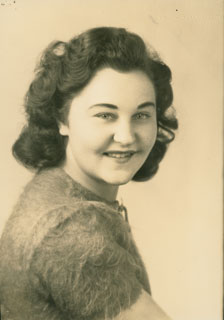
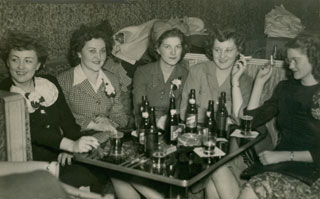
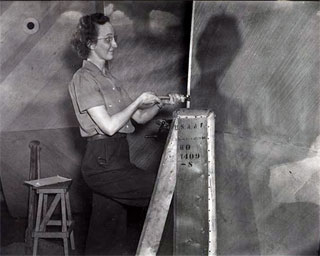
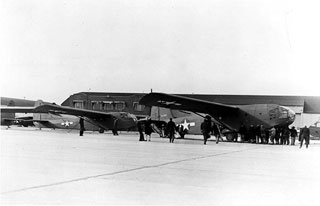
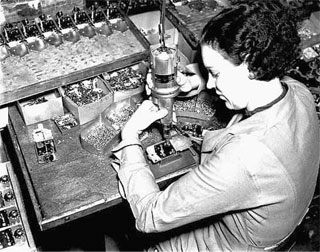

Source
Vandeputte, Kae Eisenreich; Brian Horrigan, Interviewer, Kae Eisenreich Vandeputte Oral History Interview, Minnesota Historical Society, Minnesota's Greatest Generation Project, 2007.
Lindley, John M., "A great experience": Villaume builds gliders in World War II. Ramsey County History. St. Paul: Ramsey County Historical Society, vol. 41, no. 4, Winter 2007, p. 22-27.


